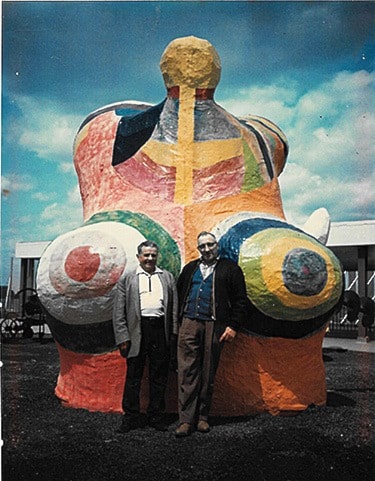By sheer coincidence, I am sorting through boxes of old family photographs during Canada’s sesquicentennial and came across one celebrating our first 100 years, a shot of both my grandfathers at Expo 67 in front a very Daliesque statue.
They met only once and were polar opposites in personality, with Franz being a man of the world who had immigrated from Austria, and Norbert a conservative stay-at-home sort of guy with deep French Canadian roots, going back to the late 1600s.
Yet they found some common ground in their admiration for ‘modern art’.
Both were gardeners in their own ways, with Franz fussing over the Okanagan grape vines he used for making wine, and Norbert sticking to the conventional vegetable garden to help feed his large family (seven kids) in southern Ontario.
The photo included is actually a great slice of Canadiana, an honest reflection of who we really are – an eclectic assortment of people from around the world (with the exception of First Nations) looking for some sort of culture to call our own.
When it comes to plant selection, we hold these same eclectic values and, unbeknownst to most of us, our nation has produced many fine cultivars over the years.
Let’s start with Agriculture Canada’s research station in Summerland, which has been breeding sweet cherries since 1936, some of which are growing in your gardens right now.
Many of these have also become important commercial varieties, such as the first introduction in 1944, called ‘Van’.
It then focused on creating self-fertile cultivars, with the first of these being ‘Stella,’ which came out in 1968. This was followed by ‘Lapins’ (1984), which I consider one of the best backyard varieties, as well as ‘Sweetheart’ (1995), ‘Skeena’ (1999) and ‘Sandra Rose’ (2005).
Women also played an important role in our early horticultural endeavors as evidenced by Miss Isabella Preston’s work at the Central Experimental Farm in Ottawa during the 1920s. She crossed Syringa reflexa and Syringa villosa (among other species) to create a Zone 2 hardy group of bush lilacs known as Syringa x prestoniae, or Preston lilacs. These bloom later than the traditional French lilac and are not prone to foliar blights in coastal climates, although the foliage proper is a bit coarse.
The flowers are quite large, but often lightly scented, with ‘Minuet’ (lavender-pink), ‘James MacFarlane’ (true pink), ‘Miss Canada’ (rosy-pink) and ‘Donald Wyman’ (lilac-pink) all to be found today.
The Central Experimental Farm in Ottawa was also home to the Explorer Series of rugosa roses, many of which were bred by another famous woman of horticulture, Dr. Felicitas Svejda. This Austrian-born horticulturist just passed away in 2016 at the age of 95, but she left us with some of our most durable and often fragrant roses, including ‘David Thompson’ (pink 1970), ‘John Franklin’ (red 1970), ‘Jens Munk’ (pink 1964), ‘John Davis’ (soft pink 1977) and ‘Martin Frobisher’ (pale pink 1961).
The Morden Research Station in southern Manitoba was established in 1915 and is probably best known for producing the Parkland Series of roses in order to provide prairie gardeners with reliably hardy cultivars.
These are also excellent choices for massing or commercial landscapes and include ‘Adelaide Hoodless’ (bright red 1964), ‘Morden Blush’ (pale pink 1976), ‘Winnipeg Parks’ (deep pink 1981) and ‘Hope for Humanity’ (burgundy-red 1984).
For those of you hoping to grow that great Canadian plant, but with limited growing space, I suggest you contact the Pitt Meadows Community Garden at pmcg.ca and secure one of the many 15-by-15’ plots available.
Mike Lascelle is a local nursery manager and gardening author (hebe_acer@hotmail.com).
